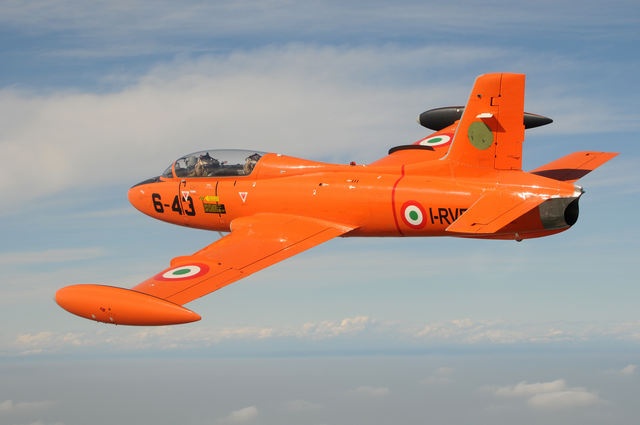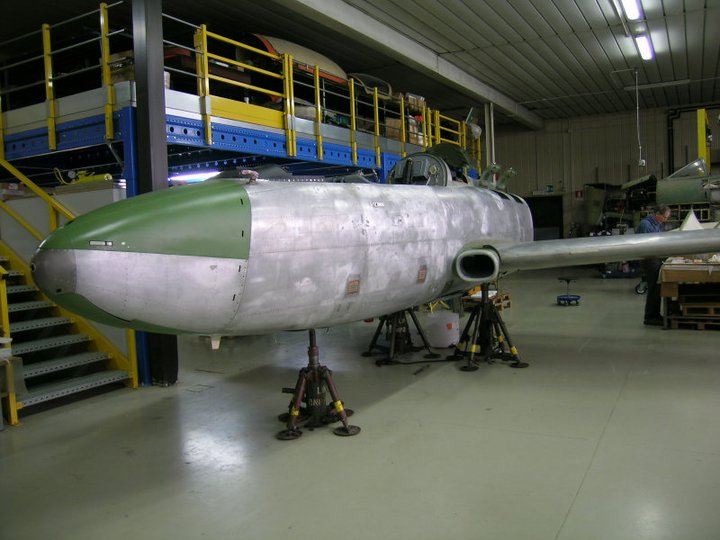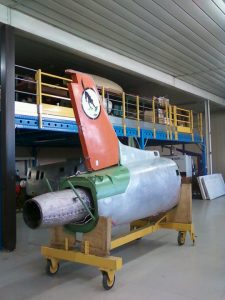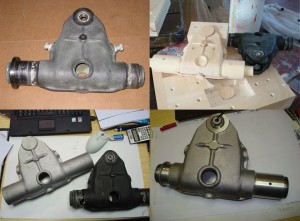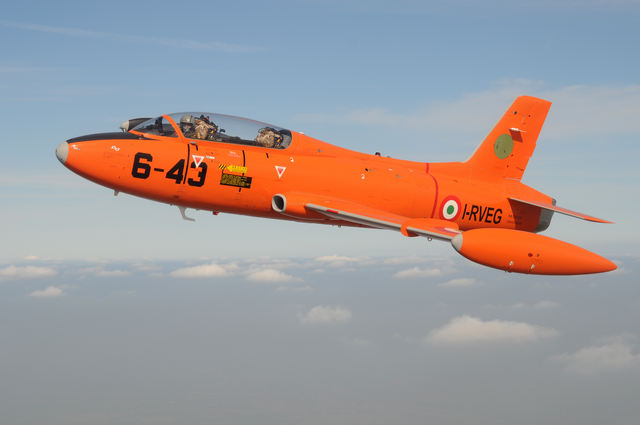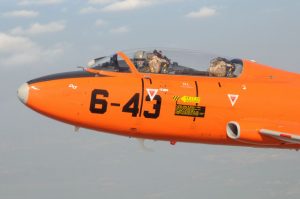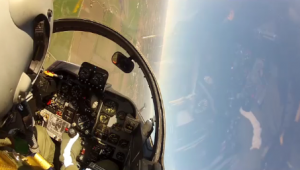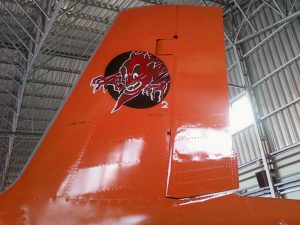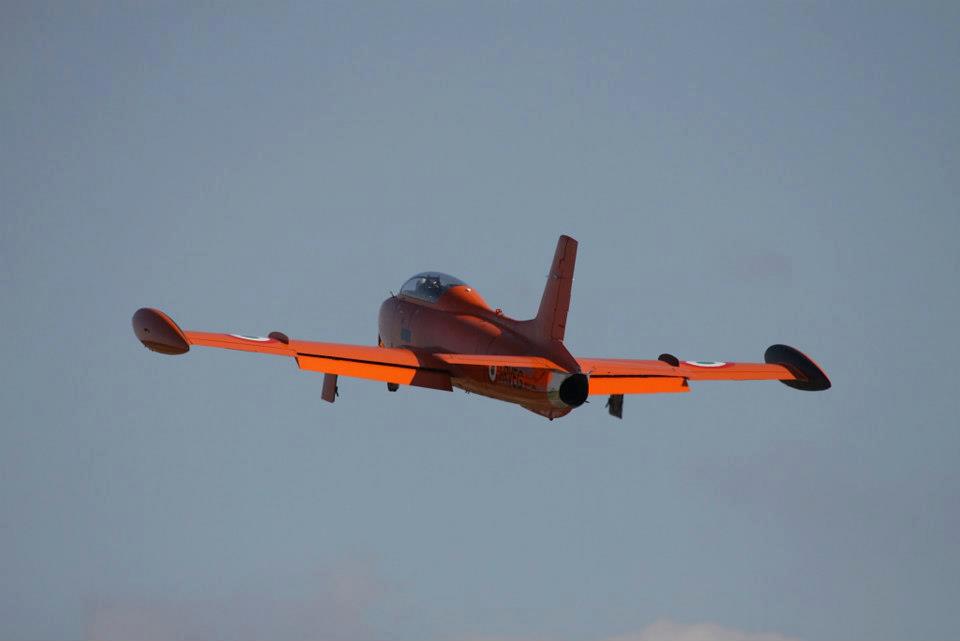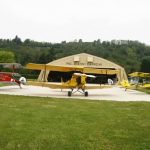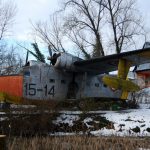
(Image Credit: Volafenice)
As we recently reported, this year marks the centenary of Italian aerospace firm Alenia Aermacchi, which got it’s start in 1913 with a crew of 10 employees building the first Nieuport-Macchi monoplane in 1913. In the 100 years since, through two world wars, the ups and downs of mergers and acquisitions, economic booms and busts, Aermacchi persevered and has grown to the industrial giant it is today, employing over 12,000 people and and producing some of the most advanced aerospace products in the world.
Poetically, one of the company’s most iconic aircraft, an Aermacchi MB-326 has recently been restored to flying condition and has returned to the skies of Italy. The Aermacchi or Macchi MB-326 was a light military jet trainer aircraft first produced in 1961 with several light attack variants later produced. It is one of the most commercially successful aircraft of its type, operated by more than 10 countries and produced under licence in Australia, Brazil and South Africa with a production run that ran for 15 years and resulted in approximately 650 Planes, some of which continued to serve within their respective air forces well into this century. The MB-326 set many category records in the mid-sixties, firmly establishing the plane as the best in its class and significantly, it was one of the last Italian aircraft to set any world records.
The restoration of Aermacchi MB-326 I-RVEG was undertaken by Museo Volante Vola Fenice (English: “Phoenix Flying Museum”) the aircraft division of Museo dell’Araba Fenice (English: “Museum of the Phoenix”) an aviation history museum in Parma, Italy. We had the opportunity to sit down with the president of the organization, Renzo Catellani at his hanger at the Reggio Emilia Airfield, located halfway between Parma and Modena, Italy. Surrounded by some of the planes from his flying collection, the aforementioned MB 326, BAC Jet Provost I-PROV, Mudry CAP 10 F-GKJI and Cessna L-19 Bird Dog I-EIAW one could feel the presence of history and the eye of a collector with an obviously educated appreciation for vintage aircraft. We also learned, unsurprisingly that Catellani is an active member of the Historic Aircraft Group (HAG), which is the biggest and most influential vintage aircraft restoration society in the country.
Catellani has always had a passion for airplanes and flying, first founding the Museum of the Phoenix to collect and educate the public about aviation history before creating its subsidiary Phoenix Flying Museum which is tasked with restoring and operating historic aircraft. The flying museum got its start when Catellani acquired the remains of a SAIMAN 202 and two airworthy aircraft, an ex-Italian Army Cessna O-1E and a Mudry Cap 10 that had formerly flown with the Italian Air Force. In the years that followed the collection was further expanded with Renzo acquiring a Fiat G.91T, a G.91R and the Aermacci MB326 with the intention of returning to the air some of the more significant aircraft in the history of Italian military aviation.
The ambitious restoration of the MB-326E began in 2006 after the plane was acquired from the now-defunct Deltaland aviation attraction in San Possidonio, Italy where the plane had been on open air display, exposed to the elements, slowly deteriorating for nearly 20 years.
The MB-326 was completely disassembled and rebuilt by the technicians of the flying museum and after six years of work, in the hands of test pilot Comandante Sergio Comitini, the “Macchino” once again graced Italian skies. Subsequent flight testing was performed by another Italian test pilot, who is more famous for his achievements as a pilot for the Aeronautica Militare (Italian Air Force) aerobatic team, the Frecce Tricolori (Tricolor Arrows), Gian Battista Molinaro.
Particularly rewarding for Renzo, he was able to perform his first solo flight in the Macchi this year on April 4th, which he says was particularly emotional experience for him, the culmination of years of hard work on this project.
(Image Credit: Volafenice)
Over the course of the restoration there were constant reminders of just how daunting a task they had taken on trying to return the aged warbird to the air. While at first glance the exterior of the craft appeared to be in fair condition, there was severe corrosion in several structural components which required the replacement of several vital elements of the airframe. This being the reconstruction of a military aircraft, and one 20-years out of service meant that many parts that were essential for the plane’s return to an operable condition were simply unavailable and required manufacturing the parts from scratch. Without the assistance of Catellani’s friend and machining expert, Albino Panigari as well as countless other enthusiasts within the aviation community and the generous help of local engineers and fabrication companies the restoration simply wouldn’t have been possible. Fortunately the engine within the neglected plane was practically new at the time of its decommissioning so the overhaul was a relatively easy task, to the extent that one can ever make that assertion about rebuilding a jet engine. At present they are in the process of overhauling a second Rolls-Royce Viper turbojet power plant that they acquired so the plane will have a new engine, already prepped for installation, as a ready spare.
We were eager to know Renzo’s impressions flying this jet, particularly in comparison to general aviation aircraft. As he had no previous experience with jets and was very aware of the difficulty and professionalism that is considered essential for flying a jet warbird, a few years ago he acquired the collection’s Jet Provost to utilize as his trainer to prepare him for the Macchi figuring it would provide a rough equivalent of the flight experience. He racked up 50 flying hours in the British jet and became proficient in its operation.
When he finally got to fly the Macchi, he was surprised at how different its handling characteristics were from the Provost and found that the Macchi was much easier to fly. As Renzo describes it, “On take off, the aircraft starts slowly in the roll, and then lets you feel the acceleration in a decisive manner. The flying controls become effective at around 45-50 knots, but before this speed there is little to do apart from a quick dab of the brakes: once on track, thanks to the truly excellent design of the undercarriage, the 326 runs straight down the runway until it reaches rotation speed, which in standard configuration occurs at around 80 knots, with liftoff occurring about 10 knots later. Once airborne the 326 is fantastic! It behaves like a faithful puppy, and unhesitatingly follows all of my commands: the stick and rudder pedals respond with uncommon rapidity and mentally it seems close to the sensation of flying that I’ve gained in the more “nervous” CAP 10, rather than the “placid” high wing Cessna.”
The excitement that Renzo feels when describing the experience of piloting this jet is palpable and contagious. He continued, “The 326 is extremely silent (considering the type of aircraft …), and the 2,500 lbs (1,132 kg) of thrust at maximum power gives a sensation of extreme safety, the aircraft climbs like a marvel, and maneuvers with sensitivity to control inputs. Like all jet aircraft, there is a slight delay of around 2 or 3 seconds between moving the throtte and feeling the effect on velocity, which is something I have to keep in mind as most of my experience has been on piston aircraft. The external visibility is fairly good, all things considered, and in any case, the configuration of the cockpit, located forward of the wing, offers better sight-lines looking up rather than forward, made even more so by the gunsight in the cockpit which blocks a portion of the forward view. Stall, in both clean and dirty configurations, is predictable, and I can judge the 326 as a good “faithful family friend”, as the plane begins to warn the pilot well in advance that it does not like the flight parameters with a easy to discern “buffetting” on the nose. The sole “defect,” I would have to say, which has a big impact on a private operator is fuel consumption. At sea level in “best cruise” (throttle at 76%, giving 213 knots airspeed) the fuel consumption much greater than the single engine monoplanes I am familiar with, improving only during high altitude flight, although this does take away some of the pleasure of the flight experience. It is perhaps in the landing phase that I really appreciate that I am flying a high performance jet and not my tranquil “Bird Dog”: the ground flashes past quite rapidly beneath, and the fast approach to the runway (on final I maintain 110 kts, around 200 km/h), requires all my concentration!”
We spoke about the history of this particular plane, Aermacchi MB-326, c/n 6172/19, today registered as I-RVEG. The jet was delivered with the military registration number of 54168 to the Scuola Volo Basico Iniziale Aviogetti (Basic Jet Flight School) at Lecce-Galatina in southern Italy in March 1962, finished in the standard high visibility orange livery of an Italian Air Force trainer and was assigned the individual code “68.” In 1975, during an overhaul by Aermacchi, it was converted into an MB-326E, the armed version of the aircraft of which only 12 examples were delivered to the Italian Air Force (six being new builds and six conversions of existing 326s). This particular variant of the aircraft was characterised by the capacity to accommodate armaments such as rockets, bombs and gun pods on six under wing pylons and was also fitted with a gun camera and gunsight. The plane was also equipped with more sophisticated avionics, including a miniaturized tactical air navigation system. Once back with its unit, the aircraft received the new individual code “70” and continued to serve with the school at Lecce until 1985 when, with the entry into service of the new Aermacchi MB-339 a few of the MB 326s were assigned to the squadrons of various frontline units. The plane was assigned, with code 9-01, to the Italian Air Force 609° Squadron of the 9° Stormo (wing), staying with this unit for around one year before transferring to Ghedi, to fly in the colours of the “Diavolo Rosso” (Red Devil) of the 6° Stormo C.B. now coded “6-43”. The plane was retired from active service in 1989 and the aircraft was acquired for open air display at the Deltaland aviation attraction located at an airstrip in San Possidonio, Italy where it languished for almost twenty years before being recovered by Vola Fenice in 2006.
Renzo was determined to accomplish the restoration of the Macchi, feeling he needed to demonstrate that Italians are not a people who ignore their history and their achievements, indicating that the successful return of this plane to the sky shows the enormous affection and enthusiasm this project received from its supporters who provided assistance in getting this complex craft airworthy. He put it succinctly: “The effort was worth it.” Continuing, he said “I must single out some of the crucial participants in this reconstruction: Giulio Cesare Valdonio, Dario Pizzolato, Riccardo Mosca, Valter Mocchi, Roberto Marzi and Mauro Marcon: without them this unique example of the Aermacchi MB-326 would perhaps be in the kitchens of our wives, in the form of saucepans and pots… Thanks boys!”
We wish to thank Renzo Catellani and his team for taking the time out to speak with us, and of course for preserving such a beautiful warbird for the enjoyment of all.A special thanks to Luigino Caliaro for helping with the drafting of the article and the interview with Renzo Catellani.








